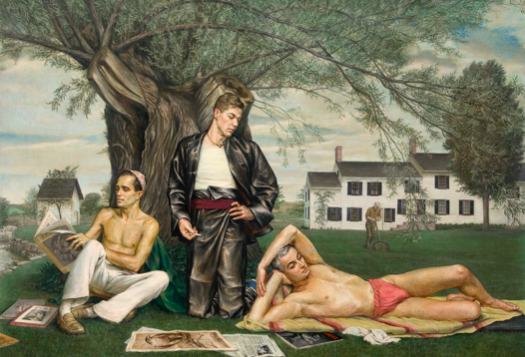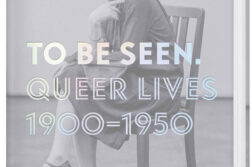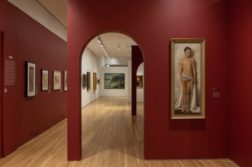THREE YEARS AGO, Gregory Woods published a book called Homintern: How Gay Culture Liberated the Modern World, about the important role that gay relations (between lovers and/or fellow travelers) played in the artistic and literary circles of the late 19th and early 20th centuries. This idea was not new, of course, but the book put a lot of flesh on it. And this spring in New York, there are several art exhibits that bring it to life in vivid and exciting ways, mixing artistic masterpieces with artifacts illuminating the relations between these lovers, friends, and circles, and the artistic products that they worked on individually (e.g. paintings, sculptures, photographs) and collectively (e.g. ballets, co-written books, magazines).
I have seen two of these shows so far, but since one of them is only up until April 13, I thought it would be good to tell you about them right away. The Young and Evil is also totally explicit about the sexual side of the artists’ work and their sexual relations with each other. Named for a 1933 novel about the gay NYC party scene of the 1920s and ’30s, the show centers on a group of lovers and friends that included painter Paul Cadmus, photographer George Platt Lynes, and impresario Lincoln Kirstein (who also the subjects of David Leddick’s 2000 Intimate Companions: A Triography of George Platt Lynes, Paul Cadmus, Lincoln Kirstein, and Their Circle).
The exhibition displays a number of rarely seen works, many of which embody the gay networks that are at the heart of the show. Two examples are a Pavel Tchelichev painting of George Platt Lynes working in his studio, and a Paul Cadmus triple portrait of George Platt Lynes with the two other members of the ménage-à-trois in which he lived for many years, Monroe Wheeler and Glenway Wescott. I was particularly excited to see this latter painting, Stone Blossom: A Conversation Piece. Although it is owned by the MFA in Boston, it has never to my knowledge been on display there. The exhibit also contains interesting memorabilia, including photographs from a file among Monroe Wheeler’s papers labeled “Intimacies” of an erect penis, seemingly that of George Platt Lynes.
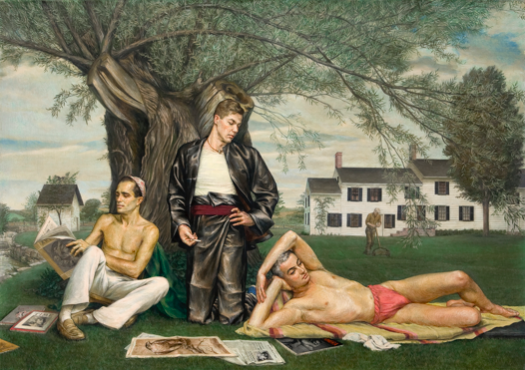
There is also a lovely exhibit, Hymn to Apollo: The Ancient World and the Ballets Russes, on the ways in which the Ballets Russes was inspired by the art of the ancient world, mainly that of ancient Greece. Like The Young and Evil, the exhibit includes a large number of artists in 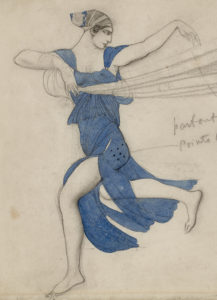 various genres and displays work in many media, including paintings, sculptures, photos, sketches, costumes, videos, and more. The exhibit does not concentrate on the gay side of the Ballets Russes, but it was of course an important side, and many of the artists whose works are displayed or who are themselves represented were part of the gay subculture surrounding the impresario Serge Diaghilev. Of these artists, the show is particularly rich in works by the multitalented artist-designer Léon Bakst and of course images of Vaslav Nijinsky—including a copy of a bust by Una Troubridge, Radclyffe Hall’s lover—a work which, it seems to me, points to the larger world of gay artistic circles in which the Ballets Russes’ gay circle was embedded. The general theme of the exhibit also points to the gay tone of this art scene, since for people of the Modernist period ancient Greece served not only to inspire their art but also to validate (and presumably to shape) their sexualities.
various genres and displays work in many media, including paintings, sculptures, photos, sketches, costumes, videos, and more. The exhibit does not concentrate on the gay side of the Ballets Russes, but it was of course an important side, and many of the artists whose works are displayed or who are themselves represented were part of the gay subculture surrounding the impresario Serge Diaghilev. Of these artists, the show is particularly rich in works by the multitalented artist-designer Léon Bakst and of course images of Vaslav Nijinsky—including a copy of a bust by Una Troubridge, Radclyffe Hall’s lover—a work which, it seems to me, points to the larger world of gay artistic circles in which the Ballets Russes’ gay circle was embedded. The general theme of the exhibit also points to the gay tone of this art scene, since for people of the Modernist period ancient Greece served not only to inspire their art but also to validate (and presumably to shape) their sexualities.
Finally, there is also an exhibit about a protean figure of the modernist art world, Lincoln Kirstein, and his relationship to the Museum of Modern Art, Lincoln Kirstein’s Modern. Kirstein and his wife Fidelma, Paul Cadmus’ sister, both appear in The Young and Evil. As the cofounder with Georges Balanchine of the New York City Ballet, he’s also the key link between the artistic networks of the two other exhibits. Indeed, the three exhibits can be seen together as a mega-exhibit about the role of gay love and gay social circles in the Modernist period.
Do you need another reason to come to New York in the year of the 50th anniversary of the Stonewall uprising? If so, these three exhibits should provide one. And if you’re going to be in New York in the next month, don’t miss The Young and Evil in particular.
In the meantime, if you want to hear more from Professor Lear on the gay history of the arts, he can be found at the MFA Boston on Wednesday March 27. Also at New York’s last gay bookstore, BGSQD, on Thursday March 28. And at the Metropolitan Museum on Friday April 5.
Andrew Lear is the founder of Oscar Wilde Tours.


